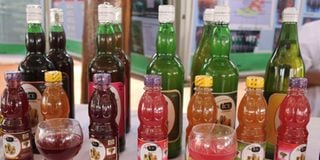Why miraa wine may rocket us to the global map

Samples of wine and juices manufactured from khat (miraa) plant.
If I were to seek your opinion on the best wine-producing regions around the globe, chances are that your answers will revolve around countries like France, Australia or the United States.
African countries are seldom in wine-producing conversations. And even for a country like South Africa, which has made a significant mark in the wine industry, it is yet to achieve production levels of countries like Italy or Spain, the latter which boasts of the most vineyards in the world.
However, at the first National Scientific Conference on miraa (khat) convened by Meru County Government and the Kenya Medical Research Institute (Kemri) and hosted by the University of Nairobi that began on October 27, the Ministry of Agriculture unveiled juices, energy drinks and alcoholic drinks derived from the herb.
The decision, which was received with praise and criticism in equal measure, was backed by the suggested upending of the listing miraa as a hard drug by Dr Fred Matiang’i, a decision that had been approved by Nacada. This comes as a reprieve for khat farmers in Meru County, who were slowly losing market for the long-standing farm produce.
The conference was attended by a powerful team of three Cabinet Secretaries led by Interior and Coordination of National Government Dr. Fred Matiang’i, accompanied by Peter Munya (Agriculture) and their Industrialisation colleague Betty Maina. Also present was the Ombudsman and former Meru Woman Representative Florence Kajuju, who chaired the Miraa Parliamentary Committee on Miraa in the 11th Parliament.
Leleshwa Wines
For many decades, miraa has been exported abroad in its raw form, thereby eliminating any chance to get value addition for it. Miraa wine, which was one of the miraa products unveiled at the one-of-a-kind conference, will serve as an addition to the sparse wineries in Kenya.
A study of the wine industry in Kenya reveals that there are currently two wineries — Leleshwa Wines, in Rift Valley, and Yatta Winery, in eastern Kenya. These wineries, albeit injecting a significant amount of profits into an economy that is still recovering from recession, are not enough to rocket Kenya to the global map in wine production.
But if miraa wine was to garner significant sales abroad, there need to be increased support from local consumers. For starters, Kenyans need to be more open-minded in the consumption of locally-made wines. And in the event that miraa is approved as a non-drug, the drinks derived from it can be made available in local wine stores and/or supermarkets so as to expand their distribution.
If we were to follow this trend, combined with the myriad miraa farms already in existence, Kenya might just be looking at the next big thing. In an economy that is still in partial recovery from the Covid-19 pandemic, any efforts to create employment, improve local production and revive the economy should be welcome.
Ms Kibugi is a freelance writer and occasional wine enthusiast. [email protected].




